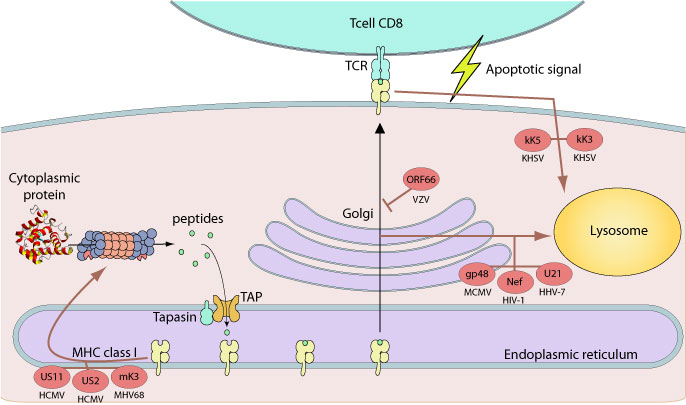Inhibition of host MHC class I molecule presentation by virus (kw:KW-1115)
After successful loading with antigenic peptide and survival of the ER quality control, the MHC class I molecules must go on to the plasma membrane in order to be reconized by cytotoxic lymphocytes.

Many viruses "intercept" the loaded MHC class I molecules and either retain it in the endoplasmic reticulum or target it to degradation in order to avoid presentation of the peptides at the cell surface. US2 and US11 of HCMV and mK3 form mouse herpesvirus 68 target human MHC class I molecules for degradation through the ERAD pathway. Other viral proteins including U21 from HHV-7 and m06 from MCMV mediate targeting of MHC molecules to the lysosomes and subsequent degradation. VZV ORF66 downregulates MHC I expression by impairing the transport of MHC I molecules from the Golgi compartment to the cell surface.
Matching UniProtKB/Swiss-Prot entries
(all links/actions below point to uniprot.org website)60 entries grouped by protein
1 entry
G-protein coupled receptor BILF1 (GPCR BILF1)
6 entries
E3 ubiquitin-protein ligase LAP (EC 2.3.2.27) (Leukemia associated protein) (LAP) (RING-type E3 ubiquitin transferase LAP)
1 entry
E3 ubiquitin-protein ligase MIR1 (EC 2.3.2.36) (MK3) (Modulator of immune recognition 1 homolog) (ORF K3) (RING-type E3 ubiquitin transferase MIR1)
45 entries
Protein Nef (3'ORF) (Negative factor) (F-protein)
1 entry
ORF7a protein (ORF7a) (Accessory protein 7a) (Protein U122) (Protein X4)
2 entries
Accessory protein p12I
1 entry
Serine/threonine-protein kinase US3 homolog (Protein kinase ORF66) (EC 2.7.11.1)
2 entries
Membrane glycoprotein US11
1 entry
